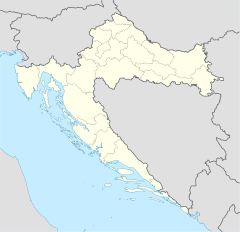Korčula (town) facts for kids
Quick facts for kids
Korčula
|
|
|---|---|
| Grad Korčula Town of Korčula |
|

Korčula Old Town
|
|
| Country | |
| County | |
| Island | Korčula |
| Government | |
| • Type | Mayor-Council |
| Area | |
| • Town | 112.4 km2 (43.4 sq mi) |
| • Urban | 4.9 km2 (1.9 sq mi) |
| Population
(2021)
|
|
| • Town | 5,415 |
| • Density | 48.176/km2 (124.78/sq mi) |
| • Urban | 2,659 |
| • Urban density | 543/km2 (1,405/sq mi) |
| Time zone | UTC+1 (CET) |
| • Summer (DST) | UTC+2 (CEST) |
| Postal code |
20260
|
| Area code(s) | +385 20 |
| Vehicle registration | DU |
| Climate | Csa |
Korčula (called Curzola in Italian) is a charming town located on the eastern side of the island of Korčula. This beautiful island is part of Croatia and sits in the clear blue Adriatic Sea. It's a place full of history and unique architecture.
Contents
People Living in Korčula
The City of Korčula is home to about 5,415 people, according to the 2021 census. This population is spread across several smaller communities, or settlements, that make up the city area.
The main town of Korčula itself has the largest population. Other settlements include Čara, Pupnat, Račišće, and Žrnovo. Each of these places adds to the unique feel of the island.
| population |
4277
|
4440
|
5004
|
5567
|
5890
|
6463
|
6518
|
5996
|
5685
|
6474
|
6157
|
6097
|
5829
|
6240
|
5889
|
5663
|
5415
|
| 1857 | 1869 | 1880 | 1890 | 1900 | 1910 | 1921 | 1931 | 1948 | 1953 | 1961 | 1971 | 1981 | 1991 | 2001 | 2011 | 2021 |
Building the Old City
The old part of Korčula town is truly special. It is completely surrounded by strong stone walls. The streets inside are laid out in a cool "herringbone" pattern. This design helps fresh air flow through the town while also protecting it from strong winds.
Korčula is built on a narrow piece of land that sticks out into the sea. This spot helps guard the small waterway between the island and the mainland. For a long time, people were not allowed to build outside these walls. The old wooden drawbridge, which was the only way in, was replaced by a new one in 1863.
Most of Korčula's narrow streets have steps, making them fun to explore. But there's one street along the southeastern wall that doesn't have steps. People call it the Street of Thoughts because you didn't have to worry about climbing stairs there!
Historic Places to See
Korčula is packed with amazing historic sites. One of the most important is the Cathedral of St Mark. It was built over many years, from 1301 to 1806, and shows off both Romanesque and Gothic styles.
You can also visit a Franciscan monastery from the 15th century. It has a beautiful Venetian Gothic cloister, which is an open walkway. Other important buildings include the civic council chambers and the palace where the old Venetian governors lived. There are also grand palaces from the 15th and 16th centuries that belonged to rich local merchant families. And don't forget the huge city fortifications that protected the town!
Amazing Architecture
Korčula's architecture is a big part of its charm. You'll see many well-preserved buildings like churches, palaces, town squares (piazzas), and towers. Most buildings in the Old Town were built in the Venetian Renaissance style. However, the famous cathedral stands out with its Gothic design.
When the city walls were built, 12 towers were added during the Middle Ages to protect the town. Today, 7 of these original towers are still standing. Some of them are Tower Zakerjan, Tower Kanavelic, and Forteca. These towers remind us of Korčula's past as a well-defended city.
The town also has many small chapels and churches hidden in its narrow streets. The most impressive architectural piece is St. Mark's Cathedral. It sits at the highest point of the peninsula. Local craftspeople, who were experts in stone masonry, built this Gothic-Renaissance style cathedral. Its front is decorated with statues, beautiful rose windows, and even lion figures. Statues of Adam and Eve frame the main entrance.
You can see a lot of Venetian architecture in Korčula's palaces. These grand homes were built using different styles like Gothic, Baroque, and Renaissance. Some popular palaces include the Arneri Palace, Governors Palace, and Gabrielis Palace. Many of these belonged to the wealthiest families in town. For example, the Arneri Palace has a Gothic front but its covered walkway uses Renaissance and Baroque styles.
Local Culture and Traditions
The people of Korčula are very proud of their traditions. They are mostly Catholic and keep alive old church ceremonies. They also perform a special weapon dance called the Moreška. This exciting dance dates all the way back to the Middle Ages.
The Moreška was originally danced only on very special occasions. But now, you can often see performances twice a week, especially for visitors. It's a thrilling show with dancers using swords!
An interesting historical fact about Korčula is that its Town Statute, which is like its old set of laws from 1214, actually made slavery illegal. This shows how forward-thinking the town was, even centuries ago.
Images for kids









